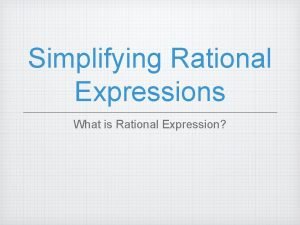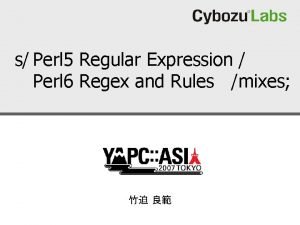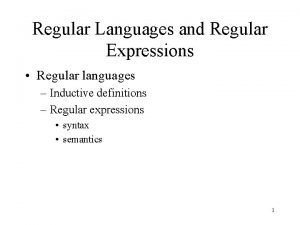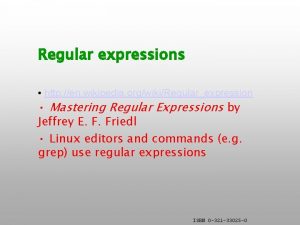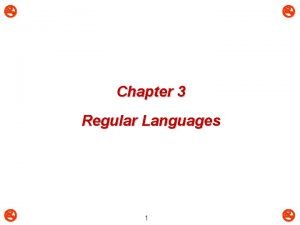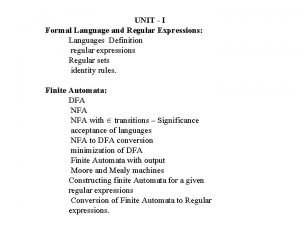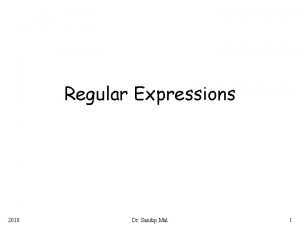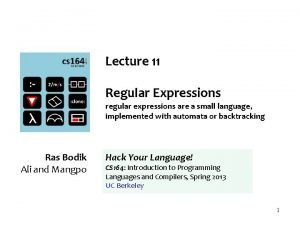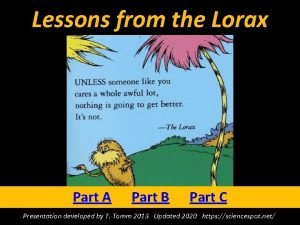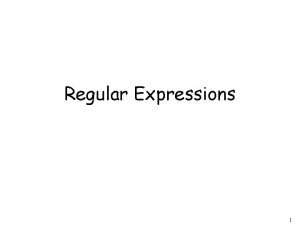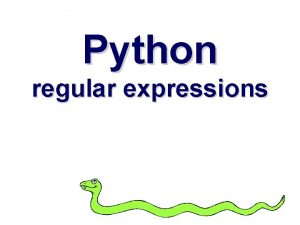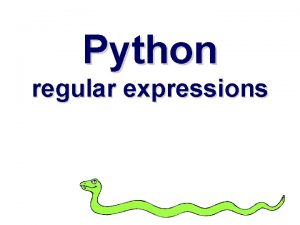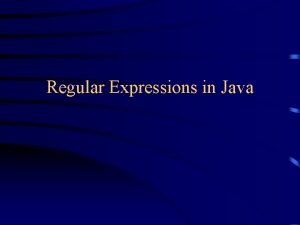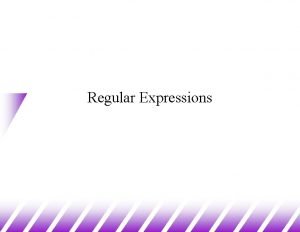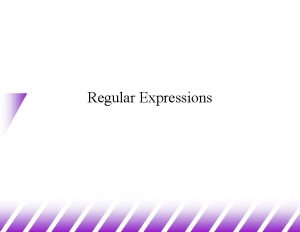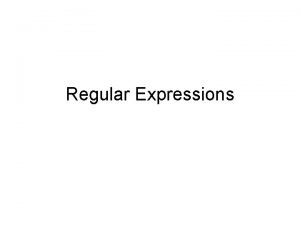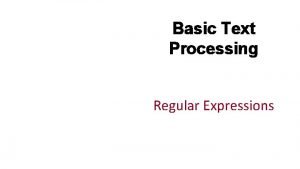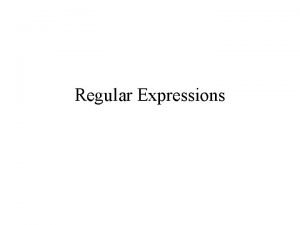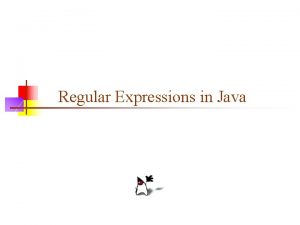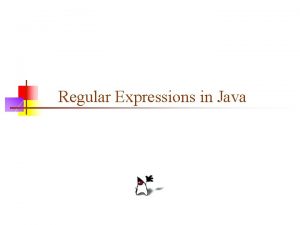Regular Expressions Sipser pages 63 66 A new















- Slides: 15

Regular Expressions Sipser pages 63 -66

A new Computation System • DFAs, NFs, ε-NFAs all describe a language in an operational manner. They describe a machine that one can execute in order to recognize a string. • An alternate method of describing a set of strings is to describe the properties it should have. • Regular-Expressions are based upon the closure properties we have studied.

Regular Expressions • Fix an alphabet S. We define now regular expressions and how each of them specifies a language. • Definition. The set of regular expressions (with respect to S) is defined inductively by the following rules: 1. The symbols and e are regular expressions 2. Every symbol aÎS is a regular expression 3. If E and F are regular expressions, then (E*), (EF) and (E+F) are regular expressions. Juxtaposition of two RE uses an implicit or concatenation Note how the closure properties are used here

Computation system as Data • We have made a big point that computation systems are just data, regular expressions are no exception. • We can represent them as data. Here we use Haskell as an example. data Reg. Exp a = Epsilon | Empty | One a | Union (Reg. Exp a) | Cat (Reg. Exp a) | Star (Reg. Exp a) ------- the empty string "" the empty set a singleton set {a} union of two Reg. Exp Concatenation Kleene closure • How would you represent regular expressions in your favorite language?

Regular Expressions as Languages • Definition. For every regular expression E, there is an associated language L(E), defined inductively as follows: 1. L( )= and L(ε)={ε} 2. L(a)={‘a’} 3. Inductive cases 1. L(E*) = (L(E))* 2. L(EF) = L(E) L(F) 3. L(E+F) = L(E) L(F) • Recall x* = ε x x x x … recall implicit use of dot L(E) L(F) Definition. A language is regular if it is of the form L(E) for some regular expression E.

Equivalence 1. We say that regular expressions E and F are equivalent iff L(E)=L(F). 2. We treat equivalent expressions as equal (just as we do with arithmetic expressions; (e. g. , 5+7 = 7+5). 3. Equivalences (E+F)+G = E+(F+G) and (EF)G=E(FG) allow us to omit many parentheses when writing regular expressions. 4. Even more parentheses can be omitted when we declare the precedence ordering of the three operators : 1. star (binds tightest) 2. concatenation 3. union (binds least of all)

Regular expressions as Trees • Every RE has a tree like structure. Binding rules specify this structure. ab+cd* a(b+c)d*

RE’s over {0, 1} • Fill in the blank • • • E 1= 0+11 then L(E 1)=_____ E 2=(00+01+10+11)* then L(E 2)=____ E 3 =0*+1* then L(E 3)=_____ E 4 =(00*+11*)* then L(E 4)=_____ E 5 =(1+ε)(01)*(0+ε)then L(E 5)=_____

Computing a language • We can compute a language by using the definition of the meaning of a regular expression • L(a+b. c*) = L(a) U L(b. c*) • L(a+b. c*) = L(a) U (L(b). L(c*)) • L(a+b. c*) = {a} U ({b}. {c}*) • L(a+b. c*) = {a} U ({b}. {ε, c, ccc, …, cn}) • L(a+b. c*) = {a} U ({b, bcc, bccc, …, bcn}) • L(a+b. c*) = {a, b, bcc, bccc, …, bcn})

Laws about Regular expressions • The regular expressions form an algebra • There are many laws (just as there are laws about arithmetic (5+2)=(2+5)

Laws about + 1. 2. 3. 4. R+T=T+R R+ = +R = R R + (S + T) = (R + S) + T

Laws about. 1. R. = . R = 2. R. L = L. R = R 3. (R. S). T = R. (S. T) • With Implicit. 1. R = R = 2. RL = LR = R 3. (RS)T = R(ST)

Distributive Properties 1. R(S + T) = RS + RT 2. (S + T)R = SR + TR


Next section • We will study how to make recognizers from regular expressions • We will prove that RE and DFAs describe the same class of languages.
 Sipser, m: introduction to the theory of computation
Sipser, m: introduction to the theory of computation Printed pages vs web pages
Printed pages vs web pages Regex xkcd
Regex xkcd Simplify rational expression
Simplify rational expression Regex
Regex Regular language
Regular language Regular expressions wikipedia
Regular expressions wikipedia Regular expressions
Regular expressions Regular expressions
Regular expressions Primitive regular expressions
Primitive regular expressions Regular expressions
Regular expressions Regular grammar generates regular language
Regular grammar generates regular language Dominant rules
Dominant rules A website is a collection of
A website is a collection of Flat lorax project examples
Flat lorax project examples Hijos de pagés llergo
Hijos de pagés llergo



